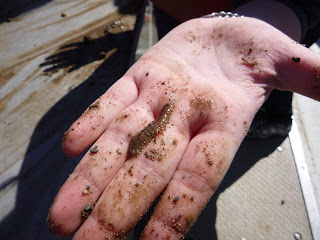Examining life in a drop of ocean water.
Feeding the salmon while touring the Huntsman Fundy Discovery Aquarium.
Collecting plankton from the bay.
We conducted a scallop or benthic drag.
Sorting through the items brought up from the ocean floor.
A brittle star.
In one of the drag we caught a lobster.
Exploring the beach at low tide.
We found lots of sea slugs (rough-mantled nudibranchs).
Most of the animals were found under rocks.
Experiencing the tide coming in at the Bar Road to Ministers Island.
In the lab studying the live animals we collected.
On a wildlife cruise in the Bay of Fundy.
We saw tons of feeding seabirds, including these Bonaparte's gulls.



























































